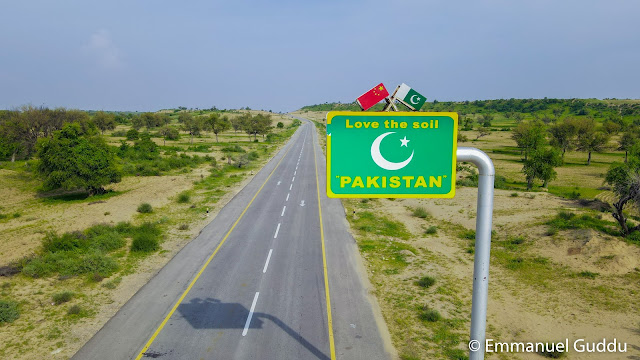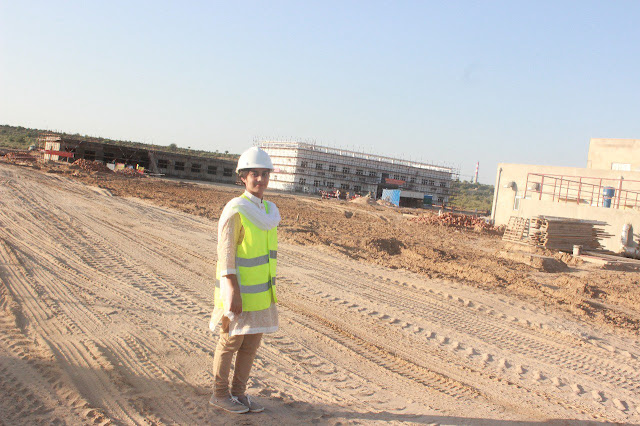

|
Tharparkar: Road Built under CPEC - Emmanuel Guddu |
Rural Pakistan: New Infrastructure Driving Socioeconomic Revolution
By Riaz Haq
CA

In a 2018 TheNew York Times Op Ed titled " How Not to Engage With Pakistan ", ex US Ambassador to Pakistan Richard G. Olson wrote: "Its (CPEC's) magnitude and its transformation of parts of Pakistan dwarf anything the United States has ever undertaken". Among the parts of Pakistan being transformed by China Pakistan Economic Corridor (CPEC) are some of the least developed regions in Balochistan and Sindh, specifically Gwadar and Thar Desert.
More recently, Pakistani architect and social activist Arif Hasan has detailed the socioeconomic impact of new infrastructure in Tharparkar district, further reinforcing what Ambassador Olson wrote about how CPEC is transforming Pakistan's least developed areas. In his book titled "Tharparkar: Drought, Development, and Social Change", author Arif Hasan has highlighted the following (excerpted from Arif Hasan's recent piece published in Dawn ):
1. New roads, airports, solar panels, cell towers and mobile phones are opening up opportunities for employment, entrepreneurship, education and healthcare for the Thari population.
2. New infrastructure is empowering Thari women to challenge the long-established patriarchy in Tharparkar. A major change has occurred in gender relations — males are less restrictive; there is an increase in education and hygiene; women now move around without male escorts. Women are giving up old traditional clothes for more fashionable dresses.
3. Road construction in Thar that started in the Musharraf era (2000-2008) has made transportation cheaper and easier. Before these new roads, the old six-wheeler kekra (WW II era American Army truck) was the only mode of vehicular transportation in the desert. It was slow and expensive. It has now been replaced by normal Bedford trucks which are cheaper to run.
4. Bank loans to buy taxis are now available. Number of taxis operating in Thar has increased from 150 to over 400, while the qingqis in Mithi have increased from over 150 to over 300 since 2013.
5. The old kekras (old American Army 6-wheelers) have been converted into water tankers; people can now actually order one by phone, to pick up potable water from Mithi and deliver it to villages.
6. The new roads have helped substantially increase trade and commerce. Thar’s agricultural produce now reaches distant markets — six to seven trucks per day carry onions from Nagarparkar to Lahore, and vegetables and fruit from other parts of Sindh and Punjab are now easily available in Thar.
7. Thari men now work in the garment industry in Karachi, where they save and send home Rs 10-12,000 a month.
8. Tourist traffic has grown in Thar with tens of thousands of people visiting the area every year after the rains and for the many religious festivals that the desert celebrates. Women producing traditional handicrafts are able to sell their wares to the tourists. This creates economic opportunities for the local population.
9. Dozens of carpentry workshops are now operating in Mithi. The carpenters have moved in from the rural areas of Thar, where they worked for the rural population, who paid them in grain.
10. Number of retail stores has also increased — in Mithi there were 20 to 25 grocery stores in 2015, as opposed to seven or eight 10 years earlier. Earlier, the store owners used to travel to Hyderabad to buy goods but, today, because of the road and mobile phone, they just order the items from Karachi and the transporter delivers them. The clients at the stores are both rural and urban.
11. Access to healthcare units in district capital Mithi is a lot easier and faster, and has been of special importance in maternity-related cases.
12. With the construction of new roads, the villagers are now more willing to send their children to school, including girls, because schools are easier to access.
Back in 2018, I wrote a post titled "CPEC is Transforming Least Developed Parts of Pakistan". Below is an except that describes Thar development:
Thar Desert
Thar, one of the least developed regions of Pakistan, is seeing unprecedented development activity in energy and infrastructure projects. New roads, airports and buildings are being built along with coal mines and power plants as part of China-Pakistan Economic Corridor (CPEC) . There are construction workers and machinery visible everywhere in the desert. Among the key beneficiaries of this boom are Thari Hindu women who are being employed by Sindh Engro Coal Mining Company (SECMC) as part of a plan to employ locals. Highlighted in recent news reports are two Hindu women in particular: Kiran Sadhwani, an engineer, and Gulaban, a truck driver.

|
Kiran Sadhwani, a Thari Hindu woman engineer - Express Tribune |
Thar Population
The region has a population of 1.6 million. Most of the residents are cattle herders. Majority of them are Hindus . The area is home to 7 million cows, goats, sheep and camels. It provides more than half of the milk, meat and leather requirements of the province. Many residents live in poverty. They are vulnerable to recurring droughts . About a quarter of them live where the coal mines are being developed, according to a report in The Wire .

|
A Hindu woman truck driver in Thar - Reuters |
Some of them are now being employed in development projects. A recent report talked of an underground coal gasification pilot project near the town of Islamkot where "workers sourced from local communities rested their heads after long-hour shifts".
|
| |
In the first phase, Sindh Engro Coal Mining Company (SECMC) is relocating 5 villages that are located in block II. SECMC is paying villagers for their homes and agricultural land.
SECMC’s chief executive officer, Shamsuddin Ahmed Shaikh, says his company "will construct model towns with all basic facilities including schools, healthcare, drinking water and filter plants and also allocate land for livestock grazing,” according to thethirdpole.net . He says that the company is paying villagers above market prices for their land – Rs. 185,000 ($ 1,900) per acre.
(Riaz Haq is a Silicon Valley-based Pakistani-American analyst and writer. He blogs at www.riazhaq.com )

